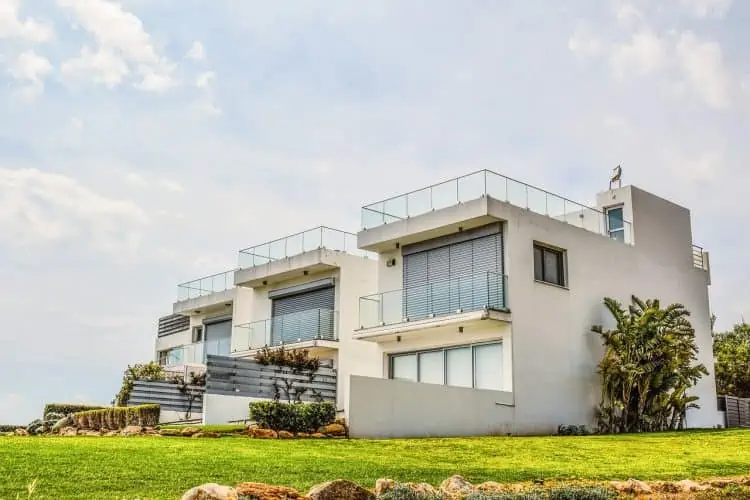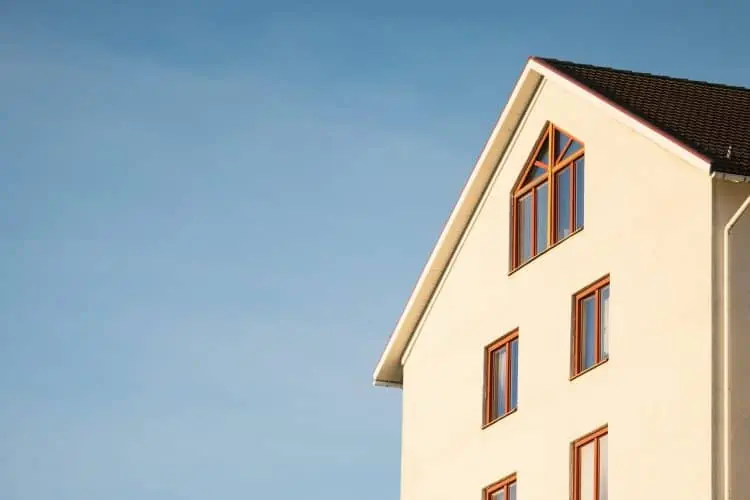If I was starting all over in my real estate investing journey, I would pay much more attention to the humble quadplex.
While single family rental properties have served me well as a real estate investor, the quadplex has some unique benefits as a real estate investment that you can’t find anywhere else.
Whether you’re looking for your first house hack, or are a seasoned real estate pro, investing in a quadplex could best thing to happen to your real estate portfolio!
What is a Quadplex?
A quadplex is a single building that is divided into four separate dwelling units. You might have heard of it by another name: quadriplex, fourplex, or four-flat.
Like it’s cousins the duplex (2 units) and the triplex (3 units), the quadplex allows for multiple households to live under the same roof. And unlike apartments, they are usually built to look more like a “normal” single family house, and provide more space both inside and out.
It doesn’t stop at quadplex either, there are 5-plexes, 10-plexes, and more.
But the quadplex is unique because it is the largest building you can buy and still qualify for a “single family” mortgage. And as you’ll see below, that is a huge benefit.
Benefits of Buying a Quadplex
1. Financing is Easy and Cheap
Quadplexes are one of the hidden loopholes of real estate investing.
Any residential 1-4 unit building qualifies for conventional financing.
In other words, you can get the same type of loan to buy a fourplex that you would to buy a single family home. This comes with a lot of benefits because the federal government guarantees and subsidizes these types of loans. Which means you can get a lower interest rate, longer term (30 years), and lower down payments vs. a commercial mortgage.
But if you add just a single unit more (i.e., a 5-plex), you are now in the realm of commercial financing.
Commercial loans can be less favorable for a variety of reasons:
- higher interest rates
- bigger down payment requirements
- not backed by government, so approval is subject to the whims of the bank
- generally max loan term of 10 years or less
With duplexes, triplexes, and quadplexes, you get the benefit of buying multiple units at a time with extremely favorable financing. And if you live in one of the units, you can even qualify for VA or FHA financing.
With FHA, you can put as little as 3.5% down, and if you are a veteran you can even put 0% down with a VA loan! There are very few ways to invest in real estate with no money, but this is one of them.
Just remember to make sure your property cash flows even with a low down payment. You never want to be losing money every month, especially if you’re over-leveraged!
If you can find a quadriplex that cash flows with 5-10% down, that is great for your overall return on equity, because you’re still making money every month with very little invested.
2. Build Your Portfolio Faster
There are some unique rules surrounding 1-4 unit residential mortgages. In most cases, you are limited to a total of 10 of these loans (sometimes as low as 4).
In my own investing journey, I hit this limit a few years ago (although we have since sold off a few of our rental properties). After that, you have no choice but to use commercial financing, even for single family homes.
If you want to maximize your ability to leverage cheap financing to build your portfolio, look no further than the quadplex.
If you invested in single family homes, you’d end up with a total of 10 units before maxing out your conventional loan quota. But if you invested entirely in quadplexes, you could have 40 units instead!
Example:
As a thought experiment, let’s say you can earn $200 in cash flow for every unit you own (I’ve personally averaged around $300 across my rental portfolio).
With 10 single family houses, you would be bringing in 10 x $200 = $2,000 per month. Not a bad side income.
But with 10 quadplexes, you would be bringing in 10 x 4 x $200 = $8,000 per month!
Of course, you have more units to deal with, but as long as you have a good property manager it shouldn’t be any extra work to you.
Also, one of the hardest parts of investing is finding a good deal to buy. So why not spend your time locating a great fourplex instead of a single family? It’s the same amount of work for 4x the rental units.
3. Let the Tenants Pay Your Mortgage
I wish I knew about house hacking when I was in my early 20’s. I guess I did something similar by buying a 3 bedroom house and renting out 2 of the bedrooms to friends.
But what if you could buy a duplex, triplex, or quadplex, live in one unit, and rent out the rest? If you are smart about your purchase, you can live for free or almost free while your tenants make your mortgage payment every month!
For example, if you bought a quadplex that met the 1% rule, and each unit rented for $1,000 per month, you’d pay $400,000. Let’s assume you put 5% down ($20,000) and take out a loan for $380,000 at 4%.
That equates to a mortgage payment of about $1,800 per month. You also have to account for taxes and insurance.
In the great state of Texas where I live, property taxes are an astronomical 2.7% per year, but you get a nice tax break down to around 2.2% if you live in the property as your personal residence (house hack for the win!) So that’s another $8,800 per year, or $733 per month.
Insurance is also high in Texas because of all the tornadoes and hail we seem to get around here. That would probably run around $2,400 per year or $200 per month. Let’s also add in another 20% of rents for repairs and vacancy to be conservative.
Let’s do some math:
Income:
- $1,000 rent per unit x 3 = $3,000 (you’re living in the 4th unit)
Expenses:
- $1800 mortgage
- $733 property taxes (ugh…Texas)
- $200 insurance
- 20% for repairs/vacancy x $3,000 rent = $600
- $3,333 Total Expenses
So you’re paying a whopping $333 per month out of pocket for your $400,000 quadplex. And don’t forget that part of your mortgage payment goes to the principal (roughly $550 per month in the first year and going up every year after).
So ignoring any appreciation, if you just factor in the equity you’re gaining from paying down the mortgage, you’re getting paid a little over $200 to live in your fourplex. That’s better than free!
4. Easier and Cheaper to Manage
While this isn’t the main reason to buy a quadplex, I do find that multi-unit properties are a little easier and cheaper to manage.
Unfortunately in my market, there are very few triplexes and quadplexes available. But we do own a duplex, so I can speak to the economies of scale a little bit.
With a fourplex, you have 4 units under one roof. If you self-manage, this makes it easier to check on your units. Instead of driving to four separate houses, everything is in one location.
You also get the benefit of less maintenance – one roof, one foundation, one yard, and the shared walls mean an overall smaller footprint to maintain.
However, some of the big ticket items are basically the same as owning a single family house. You will have 4 HVAC units and 4 water heaters, for example. So make sure you are saving an appropriate amount for the eventual replacement of these items.
You really see costs start to go down when you get into 100+ unit apartment buildings where you can afford to hire your own staff to deal with leasing and repairs instead of hiring out to third party contractors. But that is beyond the scope of this article.
Downsides of Buying a Quadplex
Overall I think quadplexes are a great buy for almost any investor. But there are a few things to watch out for.
1. Tenant Quality
All else being equal, most people would rather live in a single family house than a townhouse, duplex, or quadplex.
With a house, you get more yard space and privacy, and in my experience that means tenants stay longer (and tenant turnover is one of the biggest expenses in landlording).
A quadplex still offers more space and privacy than a large apartment complex, but it isn’t quite as desirable as a single family home.
Plus, depending on where you live, you might not be able to find quadplexes in nicer neighborhoods. While many people do quite well investing in lower-income neighborhoods, I personally prefer tenants who are able to pay a little bit more and stay a little bit longer.
My personal rule of thumb is to never own anything that rents for less than $1,000 per month. Many of your expenses are the same on a $100,000 house vs. a $400,000 house (e.g., roof, HVAC, plumbing, etc.). At the lower end, it just doesn’t make sense to me to deal with the maintenance hassle for a lot less rent than I could get elsewhere.
2. Living With Your Tenants
If you go the house hacking route and buy a quadplex to live in while renting out the extra units, understand that you will be living right next door to your tenants.
For some people, this isn’t a big deal (and maybe actually easier as you don’t have to travel to your rentals). But for others, it’s not ideal, especially if you hate conflict.
In my young and single days, I think I would have been fine living next to my tenants. But now that I am married with young kids, I like the separation of not sharing a wall and a yard with the neighbors. Plus I don’t want to be in “landlord mode” 24/7.
3. Availability
This isn’t a knock against fourplexes themselves, but it is something to consider. While many areas have an abundance of duplexes, triplexes, and quadplexes, not all areas do.
For example, in my city, it is extremely rare to see a quadplex come on the market. There just aren’t that many of them that were built. And the ones that do exist tend to be in lower-income areas where the rents don’t meet my $1,000/month threshold.
That is one reason I’ve been looking outside my current market for a new city to invest in. Roofstock has been a good tool to help me identify new markets and see what kind of inventory is out there. I haven’t made a move yet, but it’s on the list of things to do!
Time-lapse video of a quadplex under construction
Is a Quadplex a Good Investment?
Quadplexes are a great investment option for several reasons:
- You get access to mortgages with low interest rates and 30 year terms just like a single family home purchase
- You can build your rental income portfolio much quicker by buying 4 units at a time
- By living in one unit and renting out the rest, you can live for free or almost free
- Putting multiple units under one roof makes them easier and cheaper to manage
Can I Buy a Fourplex with an FHA Loan?
Yes! If you will live in one of the units as your primary residence, you can use an FHA loan to purchase a fourplex.
This is a great way to get started in real estate investing, as you can put as little as 3.5% down and use the rental income to offset the mortgage payment.
What Is a Quadplex vs. a Fourplex?
A quadplex and a fourplex are the same thing. Different parts of the country tend to use different terms (kind of like in the South we say “Coke” when talking about any carbonated beverage vs. those crazy Midwesterners who call it “Pop”).
Where I’m from, it’s generally referred to as a fourplex. Others might call it a quadplex or quadriplex. And for some reason, only in Chicago, they call it a 4-flat.
Quadplex – The Real Estate Investor’s Secret Weapon
Hopefully you learned a thing or two about quadplexes and how they might fit into your rental portfolio.
Of all the ways to invest in real estate, I think fourplexes give you some unique advantages as a landlord.
- You qualify for federally-backed financing with low down payments and interest rates
- You can build your portfolio and passive income much faster buying 4 units at a time
- As a house hack, it can allow you to live rent free
What’s your experience? Have you owned a quadplex before?
READ NEXT: How to Turn $40K into $750K With One Rental Property
Andrew Herrig is a finance expert and money nerd and the founder of Wealthy Nickel, where he writes about personal finance, side hustles, and entrepreneurship. As an avid real estate investor and owner of multiple businesses, he has a passion for helping others build wealth and shares his own family’s journey on his blog.
Andrew holds a Masters of Science in Economics from the University of Texas at Dallas and a Bachelors of Science in Electrical Engineering from Texas A&M University. He has worked as a financial analyst and accountant in many aspects of the financial world.
Andrew’s expert financial advice has been featured on CNBC, Entrepreneur, Fox News, GOBankingRates, MSN, and more.


